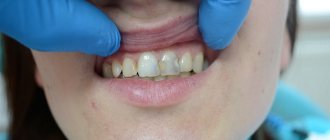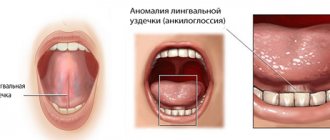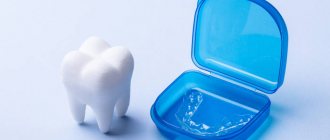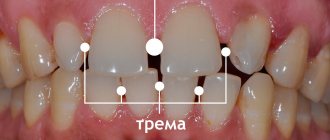About a fifth of all adults on the planet are wondering how to remove gaps (gaps) between their front teeth. Diastemas appear for various reasons: from hereditary predisposition to deformation due to bad habits.
An aesthetic defect always attracts the attention of others, since it involves the central incisors, which are visible to the naked eye, regardless of the scale of the problem. Therefore, patients may develop not only dental pathologies, but also complexes.
Modern medicine does not stand still: there are many ways to get rid of chips effectively and with minimal trauma. The optimal method should be selected exclusively by a doctor based on the clinical picture and financial capabilities of the person.
How does a diastema differ from a trema?
People often confuse these concepts out of ignorance. The differences lie in the location of the interdental spaces. In the first case, we are talking about a gap exclusively in “ones” (why gaps appear between the front teeth in adults and children will be discussed below), located on the upper or lower jaw. Sometimes the distance reaches a centimeter, but more often there are gaps of 2-5 mm. The problem is diagnosed in 50% of preschool children with temporary bites and in about ⅕ of men and women with permanent bites.
Another type of chip can be localized in various areas of both rows, but not in the center. The location of the defect depends on the factors that provoked its formation.
Preventive actions
As you know, preventing the onset of a disease is always easier and cheaper than treatment. To prevent the appearance of gaps between teeth, you must follow basic rules:
- control the habit of chewing hard objects (for example, seeds, nuts, crackers, threads, wire, etc.);
- carry out proper hygienic care of the oral cavity (to maintain the health of the gums and prevent the spread of bacteria, it is very important to brush your teeth correctly, carefully brushing not only the chewing units, but also the canines and incisors);
- Conduct timely examinations with a dentist (this allows you to diagnose any deviation in time and begin treatment at an early stage).
If the cause of the appearance of interdental gaps is a genetic predisposition, it is very important to begin correction as early as possible. Maximum effectiveness is possible during the period when the teeth are still mobile in the gums and can be rebuilt.
Now you know exactly how to remove the gap between your front teeth, what methods are used for this and how long it takes to eliminate the defect. All that remains is to consult with an orthodontist and, after examination and research, choose a method for eliminating the diastema that is right for you.
What are diastemas: what causes them
There are many varieties according to different criteria. These are classifications based on etiology, localization, and type of displacement. False and true are separated into separate blocks. The first ones occur in children and disappear as they develop. In the second case, there is a pathology in the anamnesis, which becomes a provoking factor.
The most common causes of this phenomenon:
- hereditary predisposition;
- incorrect bridle arrangement;
- partial absence of units (edentia);
- the lateral incisors are too small or not erupting;
- bad habits (chewing pen caps or other hard objects);
- unsuitable pacifier or untimely weaning from it in infancy.
Symmetrical and asymmetrical diastema
In most cases, the first type is diagnosed when the anterior units are removed at equal distances from the frenulum. The second option is much less common. Only one element of the row is deviated, the rest are located correctly.
Lateral deviation of crowns
The roots have the correct shape and position, only the superficial part diverges. Characteristic when the patient is overweight and has bad habits.
Hull displacement
The rows deviate completely, affecting the root structures. The defect is usually provoked by adentia from birth, as well as by lower fastening of the longitudinal fold, compaction of the median suture on the bone tissue.
Medial inclination of central incisors
This is the name of the gap (space) between the front teeth in both adults and children, which is considered the most difficult. The units deviate from the center and rotate along their axis. In most cases, this is due to supernumerary elements, as well as benign neoplasms in the bone structures of the maxillofacial apparatus.
Mechanism of development of gaps
The development of teeth and their location in the dentition is influenced by a large number of factors. This includes genetics and various external influences. The most significant factors include:
- violation of the deadlines for replacing milk teeth with permanent ones;
- untimely loss of baby teeth;
- short frenulum of the upper lip;
- displacement of teeth in the dentition due to loss or absence of tooth eruption;
- excessive growth of bone tissue of the palate;
- excess number of teeth in the dentition;
- insufficient width of the crowns of the teeth in relation to the length of the jaw;
- bad dental habits: chewing a pen, holding a pencil or other objects in your teeth;
- jaw injuries.
Why is an unclosed diastema dangerous?
For most patients, the gap is an aesthetic problem. This is especially true for women who want to look attractive and smile widely without fear of negative reactions from others. However, this phenomenon can also cause serious functional impairment. If no therapeutic measures are taken in a timely manner, the distance between the dental units will only increase. This threatens with such unpleasant consequences as:
- speech defects;
- malocclusion due to uneven load on the upper and lower rows;
- caries due to excessive accumulation of soft and hard deposits in the interdental spaces and the inability to regularly remove them at home with daily brushing;
- inflammatory processes and gum diseases.
Whether a chip poses a serious danger can only be determined by a doctor after a visual examination and clarification of the causes of its occurrence. Sometimes experts advise simply ignoring the small distance between the incisors, especially if the patient does not feel any psychological discomfort. But there are also situations when treatment cannot be avoided.
Consequences
Whether to correct a diastema or not is a personal matter for each patient. But it is necessary to understand that its existence may have a number of undesirable consequences and complications.
- Violation of the aesthetics of the dentition.
- Formation of malocclusion.
- Impaired diction.
- Development of caries and periodontitis.
Not to mention the fact that a gaping gap between the front teeth can cause psycho-emotional experiences for its owner and cause the formation of serious complexes.
Important! Over time, even a minor diastema can increase in size, which will require its correction and treatment.
Is it possible to remove the gap between the front teeth: how are adults and children treated?
Modern dentistry has a whole arsenal of methods with which it is possible to cope with the problem, including in just one visit to the doctor. Thanks to comprehensive high-quality diagnostics, it is possible to identify the exact causes of the defect, as well as develop effective therapeutic regimens.
Some procedures are relevant only for children. Others are suitable for patients of different ages. All manipulations must be performed by professional orthopedists, orthodontists and other specialists. This means that therapy at home will not give any results.
Curing diastema with aligners is as easy as shelling pears!
Treatment of diastema with aligners is the most comfortable for you and invisible to others.
The result of treatment is always 100% Star Smile orthodontists work in more than 70 cities of Russia, and we can offer you a competent, detailed consultation in your city - absolutely free for you!
Would you like a free consultation on diastema? After treatment with aligners, you will forever forget about this gap between your teeth, which now causes you discomfort.
How to get rid of a gap between teeth and correct the defect
There are many ways to fix the problem. The choice of the appropriate option should be entrusted to the doctor. The dentist will consider the following points:
- type of diastema;
- its dimensions;
- causes of pathology;
- general periodontal condition;
- financial capabilities of the patient.
Some methods require just one visit to the clinic. Sometimes treatment may take several years.
Surgical plastic surgery
This type of intervention is used independently or in combination with other techniques. For small children, it is enough to reduce the degree of tension of the frenulum, and the rows will gradually take on an anatomically correct position. It is likely that there are supernumerary incisors or fangs in the mouth; in this case, not only extraction (removal) will be required, but also the subsequent wearing of mouthguards and braces.
It is best to perform the operation in preschool or primary school age (5-8 years). If all manipulations are performed correctly, the gaps will be eliminated when a permanent bite is formed.
How to close a gap between teeth with implantation
Implants are permanent structures that are implanted into bone tissue. They are used in cases where aesthetic methods of eliminating the problem cannot be applied. They are installed in place of the missing units, and the gaps gradually close over time.
The system is installed for life. There is no need to grind down the crowns, the smile looks natural, and others cannot see that treatment was carried out.
The main disadvantage is the high cost (about 50 thousand rubles). There are also many contraindications to this type of therapeutic intervention.
Installation of braces
Orthodontic treatment is an effective way to remove a hole (gap) between the front teeth in adults and children. Corrective elements are glued to all units of one jaw. The orthodontist periodically changes the arches that connect the brackets to each other. Due to this, the rows shift and the gaps disappear. There are many types of systems: ceramic, lingual, metal, etc.
This is the longest option for medical intervention; it may take 1-1.5 years. The main advantage: in this way, not only interdental spaces are eliminated, but also other aesthetic problems, for example, the bite is corrected. The therapy is suitable for patients of different ages.
There are also disadvantages. For example, it is often necessary to use both jaws at once. After completing the course, the result should be consolidated, for which you need to wear retainers and mouth guards.
Correction with materials costs at least 60 thousand rubles. If you do not follow medical recommendations, relapses are possible (photos of a large gap between the tooth and gum can be found on the Internet).
Crowns and veneers
The problem takes a long time to resolve, but requires significant financial and time costs. If the distance is small, two onlays are sufficient; in more severe cases, four will be needed (for the central and lateral incisors).
First, the dentist treats the external surfaces and takes impressions. During the next visit to the dental office, the product is fixed on the dentition. The process takes about a week. If necessary, temporary structures made of composite materials are installed.
Pros:
- There is less plaque accumulation on ceramics, it is easier to clean than natural enamel, and the color will not change over time;
- high manual skills and many years of specialist experience are not required;
- you can choose any shade, even different from the original one.
Unfortunately, to achieve an aesthetic effect, serious treatment will be required, which also affects the dental nerves. If large fillings were used for restoration, crowns are installed. In addition, the ceramic composition is quite fragile, so you will have to monitor your diet and avoid eating too hard foods.
Veneers can last up to 15 years. If the structure breaks, you will have to replace it completely.
Plates for teeth
It operates on the principle of a bracket system: guides move the rows in the desired direction, and the gaps are eliminated. This method is suitable for correcting minor defects when the distance between the units is not too large. The product can be removed if necessary (for cleaning), it does not stick.
Orthodontists advise installing metal arches before reaching the age of 12. It is at this time that treatment can be most effective, and the patient will not experience discomfort from corrective measures. The intervention along with materials will cost an average of 30 thousand rubles.
Mouthguards
These are transparent silicone plates that do not injure hard and soft tissues. They do not put pressure on the mucous membranes, the client gets used to wearing them within a few days, and the discomfort completely disappears. In production, a silicone base is used, thickened in certain areas where correction is needed.
In this way you can deal with minor and large chips. Depending on the complexity of the situation, the specialist will advise installing a standard model or making it according to individual parameters using 3D modeling technology in especially severe cases. Over time, the incisors will begin to close together, so a tighter mouth guard will be needed.
For maximum effectiveness, it is recommended to wear the plates at least 22 hours a day. It is advisable to remove them only for eating or regular cleaning. On average, one product will cost 2-3 thousand rubles.
Cosmetic correction and artistic restoration
What to do if a gap appears between the front teeth of an adult or child, but there are no other problems? Such methods are effective when all dental units are located normally, and the person is only concerned about the aesthetically unattractive gap in front, which catches the eye of others. The incisors are built up in layers on the sides with a composite material of a suitable shade. To eliminate the defect, you only need one visit to the dental office; an experienced specialist can handle it in 1-1.5 hours.
Pros:
- no pain;
- safety (this is the most non-traumatic way);
- quick results;
- durability;
- the strength of hard tissues is not compromised.
Flaws:
- dental units increase in size (if they were initially large, the procedure is not recommended);
- There should be no dental pathologies; it is important to undergo treatment with a dentist in advance;
- artificial surfaces are subject to painting, for this reason it is necessary to periodically polish them;
- approximately once every 5 years it is recommended to remove structures and install new ones;
- if the distance is very large, the artistic restoration method will not be suitable.
Refusal of treatment
The decision to correct the bite, aimed at getting rid of the gap, is made by the patient. You should know that such a violation carries certain dangers both for dental health and for other systems. Food constantly gets stuck in the cracks and remains there for some time. This greatly increases the risk of caries. The distribution of the load on the cutting edge occurs unevenly, which causes abrasion of the enamel or periodontitis, and possible exposure of the roots. The gap increases over time in almost every case, and in addition, tooth mobility noticeably increases.
Cher Lloyd, a popular participant in the English release of the cult show X Factor after bite correction
In addition, this disorder provokes a deterioration in the functioning of the gastrointestinal tract, since chewing food is not performed as efficiently as necessary.
A large gap allows solid food to enter the mucous membrane, which leads to chronic trauma to the gums. This causes inflammation of the gum tissue, gingivitis.
Another complication is disruption of the temporomandibular joint, which is accompanied by pain while chewing food or talking.
Prevention of recurrence of diastema
Unfortunately, patients who have undergone effective treatment often experience recurrent defects. This is especially unpleasant if the restoration process lasted a very long time and a lot of money was spent. Poor-quality dental intervention, as well as failure to follow medical recommendations during the recovery period, can provoke the return of chips.
Sometimes people refuse the help of a surgeon or the installation of braces and insist on less radical methods, for example, artistic restoration using composites. The problem will remain unresolved, and everything will return very quickly. Also, difficulties cannot be avoided if you do not follow the advice of a specialist regarding wearing retention structures.
Is it possible to eliminate it at home?
There are situations when there is simply no money for treatment, but you really want to get rid of the defect. Unfortunately, the incisors cannot be adjusted at home without the intervention of a doctor; only a professional can help you with this using certain equipment and materials.
The only acceptable option for how to close the gap between the lower teeth is to make a homemade analogue of the braces system. It is necessary to tighten the twisted units tightly every time before going to bed for a long time. This is a relatively effective method, so there is no guarantee that it will help or not cause harm. The best way out in any such situation is to contact a qualified orthodontist.
How to prevent diastema in a child
To prevent problems from occurring in the baby, parents should regularly take him for preventive examinations to the dentist. This is especially important when there is a family history of clefts, gaps, or gaps between the front teeth. It is best to visit the dental clinic every six months.
The menu must include foods rich in phosphorus, calcium, magnesium, as well as vitamins C, D, and group B. If children eat well, their skeletal system, including the dentofacial apparatus, develops correctly.
From a very early age, it is important to teach your son or daughter to practice daily oral hygiene. The absence of pathogenic microorganisms and deposits in the mouth minimizes the development of inflammatory processes that provoke problems with the central incisors. You should also carefully ensure that the child does not suck fingers or chew pens, markers and other hard objects.
Restoration of diastemas with composite material
When all the teeth are in a normal position and the only concern is the distance between the front teeth, this can be beautifully, easily and quickly corrected with a composite material. In the patient's mouth for an hour and a half. This type of correction is called a filling, artistic restoration, or direct veneer. how it's done
- A composite material is applied to the lateral surfaces of the teeth without treatment, changing their shape and closing the gap between the teeth.
deadlines
- It will take one to two hours for both teeth.
pros
- This is the most non-traumatic
way to eliminate diastema. - The fastest way to close diastemas of all.
- Complete absence of dental treatment. No boron! Absolutely atraumatic for teeth and their nerves.
- No negative impact on the tooth and nerve.
- The likelihood of dental problems is the same as without intervention.
- The strength of the teeth is not impaired - you can bite off any acceptable food.
minuses
- We need a highly qualified dentist. With a lot of experience. Otherwise, closing the diastema will look like a filling and not an artistic restoration.
- The doctor must have a variety of aesthetic and proven materials available. To eliminate the defect beautifully and permanently. If performed poorly, the appearance of the teeth will not be ideal.
- When the distance between the front teeth is more than 2mm, the results are not always ideal:
In such cases, treatment with braces is more suitable. Or you have to use the lateral incisors. To prevent the central ones from becoming too wide: cost
- 6600-13200 rubles for one direct veneer. Depends on the scope of the intervention.
forecast
- When the work is done by a true master, composite veneers will last up to 10 - 16 years.
- Poor oral hygiene may require polishing. Once every two to four years. Takes 15-20 minutes. Costs up to 600 rubles.
- Due to the lack of treatment of the teeth, there is no effect on the nerve of the tooth. Therefore, there can be no complications.
Let's sum it up
Thus, diastema, as the distance (large hole, gap) between the front teeth is called, is a defect that can be eliminated in various ways. The optimal treatment method is selected by the attending physician depending on the causes of the pathology and the complexity of the situation. Some people live with small gaps all their lives without experiencing psychological discomfort. If indications for correction still exist, it is recommended not to delay the procedure, since an unclosed gap leads to speech defects, malocclusion and other problems that affect the quality of life.
Causes
Among the reasons that cause the appearance of cracks are hereditary and acquired. Hereditary include:
- similar anomalies in one of the parents - this increases the risk of diastema or trema in the child;
- abnormal size or type of attachment of the labial frenulum;
- increased jaw size;
- small sizes of dental crowns;
- untimely change of teeth;
- anomalies of tooth germs.
Among the reasons that cause the appearance of cracks throughout life are:
- long-term use of a pacifier;
- artificial feeding;
- children's bad habits - biting lips, sucking fingers and other objects;
- loss of teeth without subsequent prosthetics, which causes adjacent elements to move slightly to the side;
- chronic inflammatory gum diseases;
- partial atrophy of the jaw bone.
Sometimes a gap may occur during treatment of an overbite with braces. This is a variant of the norm; the doctor adjusts the strength and direction of the pressure, so by the end of the correction the bite becomes normal.
Dakota Johnson corrected her bite and removed diastema









